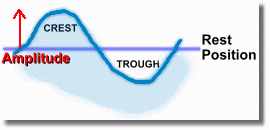|
Here are the important terms: Wavelength: the distance from one crest to another; or the length of one complete wave Amplitude: the distance from rest position to the top of the wave Frequency: the number of full waves that pass in a second Period: the length of time for one full wave to pass Speed: how fast the wave moves, in metres per second  Notice that the amplitude of a wave is the height of the wave from rest position (ie: when there are no waves). The distance from the top of a crest to the bottom of a trough is twice the amplitude. Notice that the amplitude of a wave is the height of the wave from rest position (ie: when there are no waves). The distance from the top of a crest to the bottom of a trough is twice the amplitude.We assume that the waves are symmetric, so that the crest height is the same as the trough depth. We are also assuming that the length of each is the same. This will be the case with every wave example you see in high school physics. We also will ignore reflected waves, which make the water 'choppy' by interfering with the originally generated simple wave. Individual waves move through the water one after the other. This can be described by the frequency, which is how many waves pass a spot in one second. The period is the inverse of this number, or the time for one full wave to pass. These last two quantities are related mathematically: 
Back to the Wave Pool: The crests of the main waves in the wave pool were about 4 metres apart. So one wavelength was 4 metres. The swimmers were raised into the air every 5 seconds by a wave, which means one wave was passing every 5 seconds, ... so the period of these waves was 5 seconds. Using the relation above, the frequency of the waves must have been 1/5 waves per second, or a fifth of a wave per second, or 0.2 waves per second. Knowing the frequency and wavelength of a wave, you can use the following relation to calculate the speed of the wave:  Notice the unusual symbol (the Greek letter 'lambda') for wavelength. The speed of the waves in the pool was the frequency multiplied by the wavelength, 0.2 x 4 = 0.8 m/s |